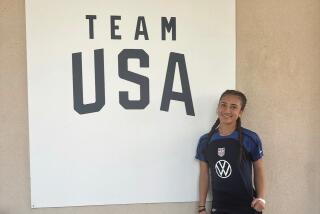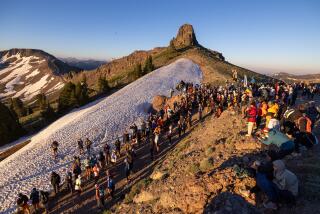RUNNING / JOHN ORTEGA : Fields Finds He Does Not Yet Have the Stomach for Retirement
- Share via
Farron Fields of Northridge almost retired from competitive distance-running this season.
That will not surprise those who know Fields. They have heard for years that this season--whether it was 1983 or 1986 or 1989--was going to be his last.
Fields, 29, has said for years that it is time for him to quit playing a kid’s game and start a business career. Yet when the 1979 graduate of Granada Hills High was unable to run for nearly two months because of stomach ulcers--giving Fields every excuse to retire--he discovered that he couldn’t give up running. At least, not yet.
“I don’t think I realized until then how much it meant to me,” Fields said. “I really missed the training and racing. I kind of went through withdrawals.”
Even when Fields got medical clearance to run last month, he figured he’d run just for fun. He didn’t want to raise his hopes too high, then have them come crashing down.
But three weeks later he is cautiously looking forward to the 1992 track season.
“I’m just taking things a day at a time right now,” Fields said. “But I would like to race again if I can stay healthy. . . . I’ve only been running again for a few weeks, but I’m really not in that bad of shape.”
Fields also would like to redeem himself for a poor effort in a 10,000-meter race in the Mt. San Antonio College Relays in April. His time, just under 30 minutes, placed him 40something--official results only went 30 deep--in the race. It was, he said, the low point in his career.
A year earlier, he finished 10th at Mt. SAC with a personal best of 28:45.9, and he ended up being ranked 10th in the United States for the year in the event.
“That was the most dreadful thing I’ve ever had to do,” Fields said. “Getting lapped by all those guys after being pretty competitive the year before was the lowest point ever. I should have dropped out, but I just couldn’t.”
That Fields ran at Mt. SAC was an accomplishment in itself.
Doctors determined in January that he had ulcers, but he continued to train, figuring that his condition would improve. Then, the day after he raced, excruciating stomach pain forced him to go to the hospital.
One doctor recommended surgery to remove the ulcers, but Fields wanted no part of that.
A second doctor prescribed medication and said that his diet--which consisted of a lot of spicy foods, coffee, soda, etc.--would have to be dramatically altered.
Fields did what the doctor ordered, going on a Malt-O-Meal diet and, 10 weeks later, the ulcers are healing and Fields has a new outlook on running.
“I’ll just see what happens,” Fields said. “Before the season, I figured that to have any shot at doing well in the (1992 Olympic) trials, I had to run well this season. . . . Things didn’t work out that way, but I’m not ready to give it up.”
Trivia time: Thirty years ago, this athlete won titles in the boys’ 100- and 220-yard dash in the California state high school meet as a junior, and he successfully defended his 100 title a year later.
Who is this former Valley-area standout?
Bad planning: Last Sunday’s tape-delayed broadcast of the NCAA Division I track and field championships is a good example of why the sport’s popularity domestically continues to plummet.
CBS showed the meet more than four weeks after its conclusion, a sure-fire way to keep viewers to a minimum.
It is doubtful that many would even watch the Super Bowl a month after the fact, so why the NCAA track championships?
CBS also tried to cram four days’ worth of highlights into a one-hour segment, which meant that very few races were shown in their entirety. Several events--such as the women’s 1,500 meters which was won by Darcy Arreola of Cal State Northridge--were not shown at all.
NBC did a fairly good job with its live coverage of The Athletics Congress championships, June 15. Other networks should follow suit.
Aged perfectly: Arreola’s selection to the U. S. team that will compete in the World University Games in Sheffield, England, in three weeks was easy to understand. Arreola finished third in the women’s 1,500 meters at the TAC meet and was the top collegiate finisher in that event.
However, some of the other selections--such as Ken Flax in the men’s hammer throw, Lacy Barnes in the women’s discus, and Juliana Yendork in the women’s long jump--need a little more explaining.
Flax exhausted his athletic eligibility at the University of Oregon in 1986, Barnes completed her senior season at Fresno State in 1988, and Yendork graduated from Walnut High last month.
None conjure up the image of a collegian --at least not yet in the case of Yendork--but according to TAC rules, they are.
As long as an athlete is at least 17 years of age and not older than 28 on the first of this year, is a U. S. citizen and is enrolled in courses at a university and working toward an undergraduate or graduate degree, he or she can be chosen to represent the United States in the World University Games.
Flax, Barnes and Yendork--who is taking summer courses at UCLA--meet those requirements.
The mighty have fallen: Has anyone noticed that Kevin Hendrix of Cal State Northridge has run nearly as fast in the 100 meters (10.44 seconds) this season as Canadian Ben Johnson (10.40)?
Hendrix had a fine collegiate career at Northridge, winning the 1990 NCAA Division II title in the 100, setting school records in the 200 (20.87) and 400 (46.81). But no one could have imagined him being at the same level this season as Johnson--who clocked 9.79 to win the 100 in the 1988 Olympics in Seoul before being stripped of his world record and gold medal for using an anabolic steroid.
Trivia answer: Forrest Beaty of Hoover High ran 9.5 seconds in the 100-yard dash and 21.5 in the 220 in the 1961 state championships, and clocked 9.5 to duplicate his 100 title in 1962.
Beaty set a national high school record of 20.2 in the straightaway 220 (no longer contested) in 1961.
More to Read
Go beyond the scoreboard
Get the latest on L.A.'s teams in the daily Sports Report newsletter.
You may occasionally receive promotional content from the Los Angeles Times.










